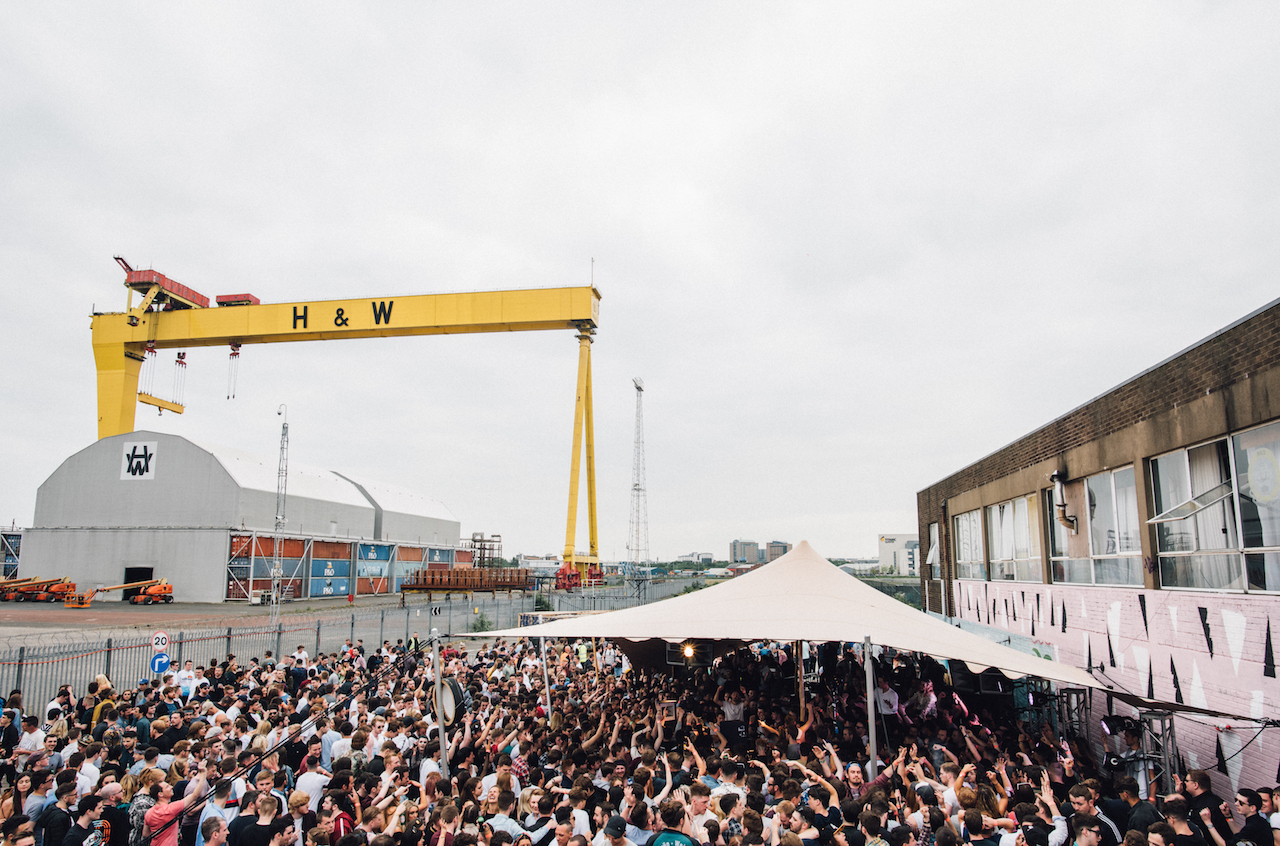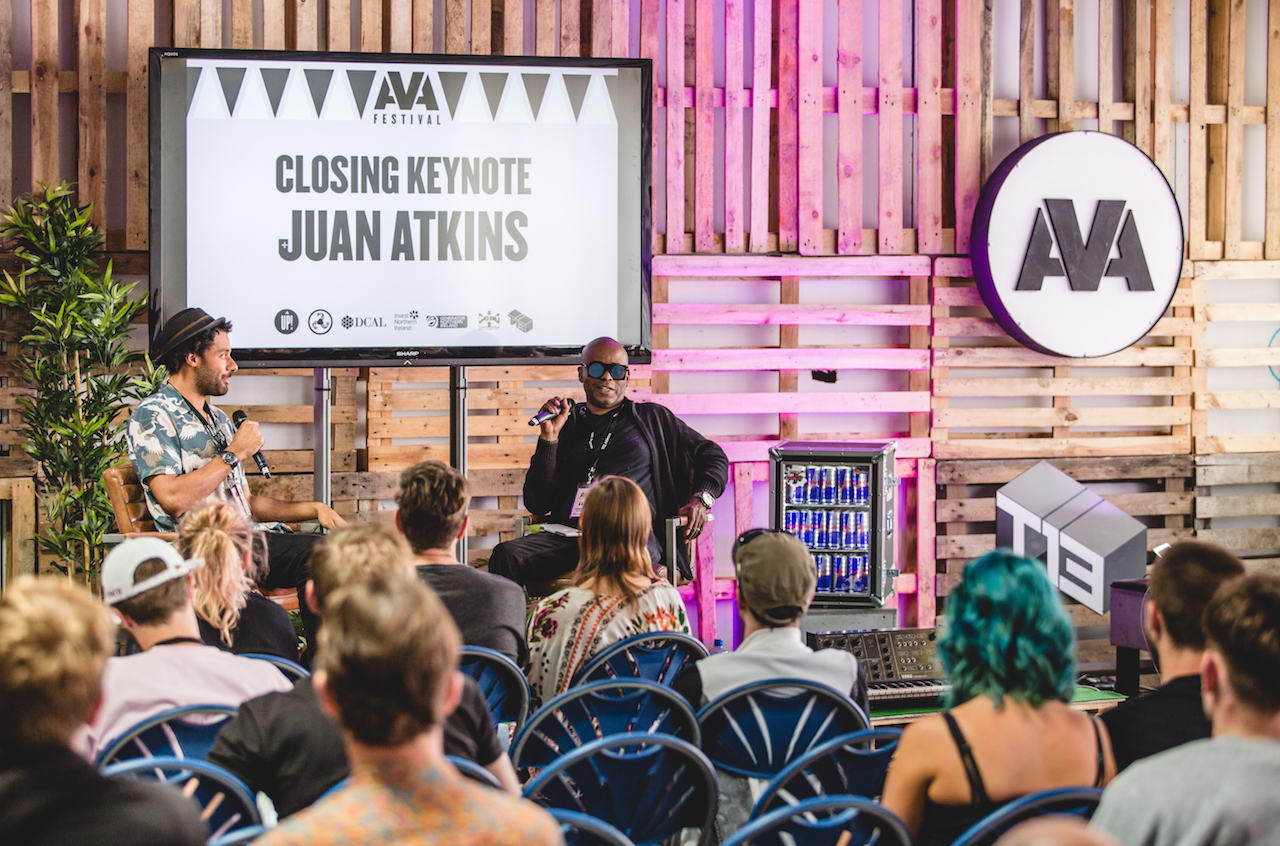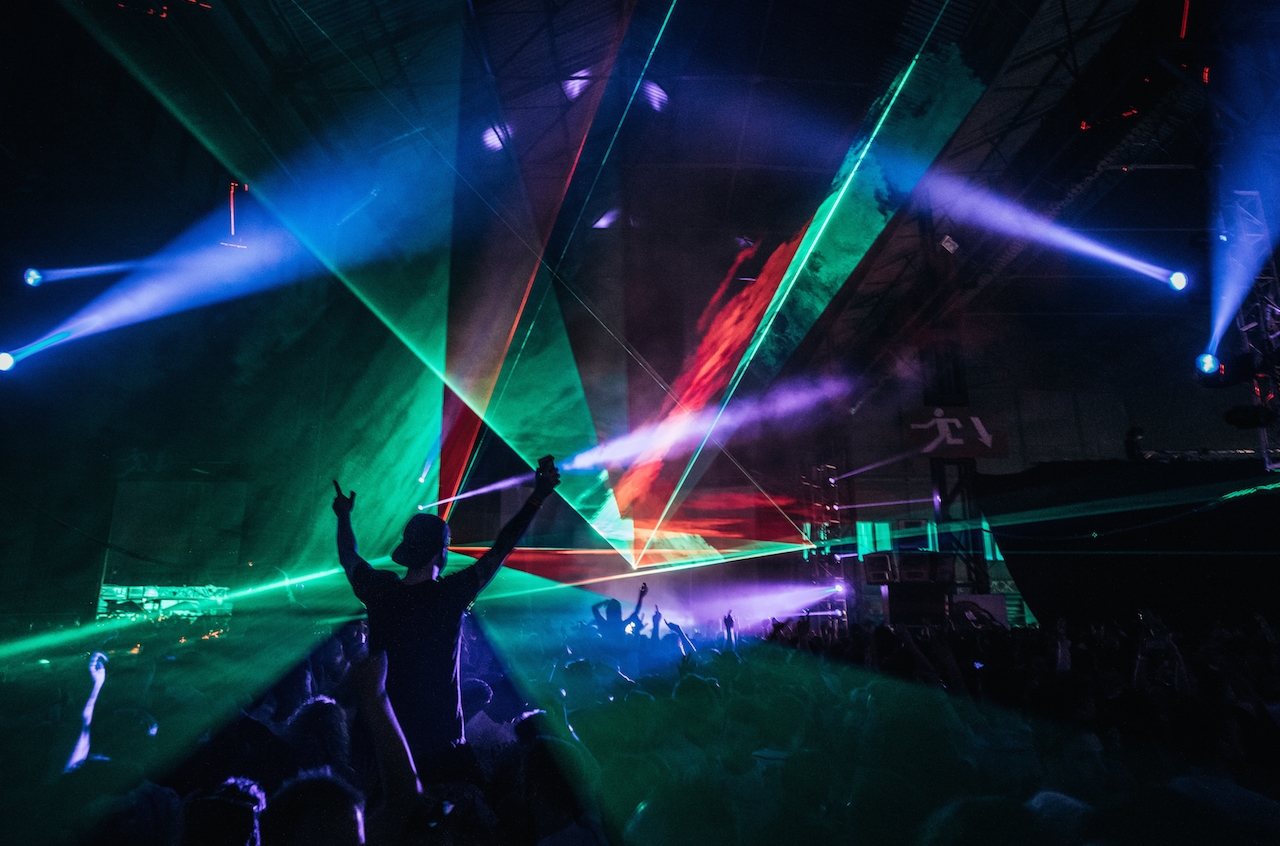- At around 10:45 PM on Saturday, as navy hues squeezed the light from the sky, a young guy in a grey marl T-shirt leaned over. "This is fucking amazing," he said. "He's the best DJ in the world." He was referring to Irish techno selector Sunil Sharpe, but this sort of declaration was, I suspect, commonplace throughout the day at Belfast's T13. The waterfront complex of cranes and former shipbuilding warehouses was the setting for AVA Festival's second edition, an event at which the majority of the several thousand attendees were Northern Irish and aged between 18 and 24. You can count on a young crowd in familiar company to show enthusiasm at any festival, but the intimacy and energy I found at AVA was something more than a sustained display of Celtic hedonism.
One particular moment at the ring-shaped Boiler Room stage will stay with me for a while. With space at a premium, some began to hoist themselves onto the raised wooden decking, while others clambered onto their mates' shoulders. As people crammed in closer to catch a sight of the DJ, Phil Kieran, those with an elevated view began to raise their fists, water bottles, smartphones and voices. The scene soon resembled a Roman amphitheatre, but once the crowd broke into song—Gala's "Freed From Desire"—the vibe was more like that at a football stadium. Optimo's JD Twitch described it as "one of the most intense experiences I've ever had." On the perimeter of the stage, myself and others laughed in disbelief at the crescendo of ecstasy.
As memorable as Kieran's hour was, my festival highlight—musically, at least—was Optimo. The DJ duo play Belfast regularly, and they know what works there better than most. Scaffolded by "Spastik"-style drum tracks, '90s rave stabs and timeless house vocals, their performance offset brute force with imaginative flourishes like Johnny Wakelin's "In Zaire," a tribute to the recently departed Muhammad Ali, and an edit that laid a Bronski Beat acapella over the elastic swing of Denis Sulta's "Nein Fortiate." I found out later that Wilkes had been DJing a few hundred yards away from a warehouse he once worked in as a 17-year-old, in the shadow of the yellow Samson And Goliath cranes that overlooked the site.
If you've ever arrived early to a club night in Northern Ireland, you may have picked up on the unique approach residents take to warm-up sets. In most British clubs, DJs might set the mood with slower tempos or ambient music. Some Belfast crowds might regard that as "fucking about"; punters are more easily summoned to dance here, which was evident during early slots from Schmutz and Swoose & Cromby. Local DJs also like to mix tracks that contrast sharply with one another. Psycatron, for instance, see-sawed smoothly between techno and disco, at one point striking a rare middle ground between the two: KiNK's remix of Kerrier District's "Techno, Disco."
The day began soberly at the festival's conference room, where a few dozen people slumped on blue plastic chairs and banquettes to absorb discussions on topics like the "supersizing" of festivals, the transition between DJing and playing live, and gender imbalances in the industry. The last one carried with it a pinch of irony. Of the 20-plus DJs and live acts scheduled across the Saturday, only two—Shanti Celeste and Or:la—were female. As important as it is to keep having these conversations on women in dance music, I couldn't help but feel that this issue could've been better addressed in the lineup.
In discussion with Juan Atkins sometime later, the music journalist Marcus Barnes suggested that "machines speak to each other." In the early days of Cybotron, Atkins recalled, the music was often the result of arduous negotiation between devices that, without MIDI, didn't get along that well. But misunderstandings still happen, as Terriers' live set proved. Peter Ward and Ronan Downing were undone, it later transpired, by loose cables, rendering their first 15 minutes a frustrated affair. I left the Becks stage and caught some of Bicep's live set at the main arena, an enormous warehouse with numerous bars, food trailers and sit-down areas. Supported by a milieu of projectors, laser stalks, speaker boxes and roving light columns, the tumbling arpeggios of "Just" stretched into every corner of the megastructure.
Not everyone felt at home there. Two hours earlier, Shanti Celeste worked through buoyant selections of Chicago house and chant tracks like Cultural Vibe's "Ma Foom Bey," but her easygoing style was a poor fit for the arena. The remoteness of the booth, positioned 20 feet away on a four-foot platform, underscored the feeling of detachment. As Rødhåd closed the festival, I wondered whether the light show, while impressive, had come at the expense of the rapport the DJs on other stages had with their dancers. I was reminded of Kieran, in particular, who ended his set crowdsurfing.
As a one-day festival on a brownfield site, AVA is an answer to questions posed by the decline of heavy industry and the mixed fortunes of the UK festival market. If it had simply been a dance music festival, most people would have left satisfied. But by also providing a platform for local talent and a space for the community to gather and exchange ideas—and doing so with an unfussy efficiency—AVA registered an ambition to represent Belfast as a contemporary, youthful city ready to work around its conservative politics and renew its entrepreneurial spirit.
Photo credits /
Tremaine Greeg
Simon Hutchinson
Luke Joyce
 In discussion with Juan Atkins sometime later, the music journalist Marcus Barnes suggested that "machines speak to each other." In the early days of Cybotron, Atkins recalled, the music was often the result of arduous negotiation between devices that, without MIDI, didn't get along that well. But misunderstandings still happen, as Terriers' live set proved. Peter Ward and Ronan Downing were undone, it later transpired, by loose cables, rendering their first 15 minutes a frustrated affair. I left the Becks stage and caught some of Bicep's live set at the main arena, an enormous warehouse with numerous bars, food trailers and sit-down areas. Supported by a milieu of projectors, laser stalks, speaker boxes and roving light columns, the tumbling arpeggios of "Just" stretched into every corner of the megastructure. Not everyone felt at home there. Two hours earlier, Shanti Celeste worked through buoyant selections of Chicago house and chant tracks like Cultural Vibe's "Ma Foom Bey," but her easygoing style was a poor fit for the arena. The remoteness of the booth, positioned 20 feet away on a four-foot platform, underscored the feeling of detachment. As Rødhåd closed the festival, I wondered whether the light show, while impressive, had come at the expense of the rapport the DJs on other stages had with their dancers. I was reminded of Kieran, in particular, who ended his set crowdsurfing.
In discussion with Juan Atkins sometime later, the music journalist Marcus Barnes suggested that "machines speak to each other." In the early days of Cybotron, Atkins recalled, the music was often the result of arduous negotiation between devices that, without MIDI, didn't get along that well. But misunderstandings still happen, as Terriers' live set proved. Peter Ward and Ronan Downing were undone, it later transpired, by loose cables, rendering their first 15 minutes a frustrated affair. I left the Becks stage and caught some of Bicep's live set at the main arena, an enormous warehouse with numerous bars, food trailers and sit-down areas. Supported by a milieu of projectors, laser stalks, speaker boxes and roving light columns, the tumbling arpeggios of "Just" stretched into every corner of the megastructure. Not everyone felt at home there. Two hours earlier, Shanti Celeste worked through buoyant selections of Chicago house and chant tracks like Cultural Vibe's "Ma Foom Bey," but her easygoing style was a poor fit for the arena. The remoteness of the booth, positioned 20 feet away on a four-foot platform, underscored the feeling of detachment. As Rødhåd closed the festival, I wondered whether the light show, while impressive, had come at the expense of the rapport the DJs on other stages had with their dancers. I was reminded of Kieran, in particular, who ended his set crowdsurfing. As a one-day festival on a brownfield site, AVA is an answer to questions posed by the decline of heavy industry and the mixed fortunes of the UK festival market. If it had simply been a dance music festival, most people would have left satisfied. But by also providing a platform for local talent and a space for the community to gather and exchange ideas—and doing so with an unfussy efficiency—AVA registered an ambition to represent Belfast as a contemporary, youthful city ready to work around its conservative politics and renew its entrepreneurial spirit. Photo credits / Tremaine Greeg Simon Hutchinson Luke Joyce
As a one-day festival on a brownfield site, AVA is an answer to questions posed by the decline of heavy industry and the mixed fortunes of the UK festival market. If it had simply been a dance music festival, most people would have left satisfied. But by also providing a platform for local talent and a space for the community to gather and exchange ideas—and doing so with an unfussy efficiency—AVA registered an ambition to represent Belfast as a contemporary, youthful city ready to work around its conservative politics and renew its entrepreneurial spirit. Photo credits / Tremaine Greeg Simon Hutchinson Luke Joyce